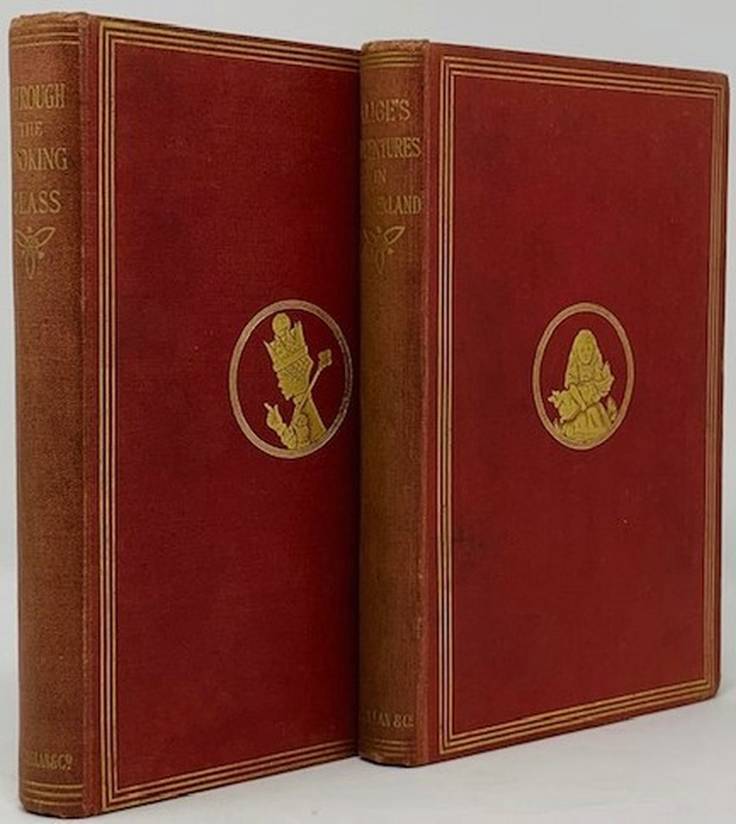CARROLL, LEWIS (AUTHOR) TENNIEL, JOHN (ILLUSTRATOR) CARROLL, LEWIS (AUTEUR) TENNIEL, JOHN (ILLUSTRATEUR). Alice’s Adventures in Wonderland [and] Through The Looking-Glass And What Alice Found There Les aventures d’Alice au pays des merveilles [et] à travers le miroir et ce qu’Alice y a trouvé. 1932.
Лот 772
8 0009 000
London, Macmillan And Co.,
Limited 1932. 8vo. 2 vols; publisher’s red cloth with triple-line panels to sides enclosing pictorial roundels to all 4 boards, spines lettered
and decorated in gilt, all edges gilt; pp. [xiv] + 195 + [i]; [xvi] + 227 + [i] + [2], adverts.; with a total of 92 fine illustrations after the original wood-engravings by Tenniel; clean and attractive copies forming a convincing pair, with a gentle patina of age, uniform fading to spines, light overall rubbing, and some pinkish bleed to lower margin of front pastedown of Wonderland, otherwise internally clean and sound throughout.
Sold with a loosely-inserted 3-page autograph letter signed in ink by illustrator John Tenniel on laid headed notepaper «10, Portsdown
Road, Maida Hill, W.», watermarked Parkins & Gotto, and dated April 1, 1901, addressed to the British poet and critic William Cosmo Monkhouse (18 March 1840 – 20 July 1901) just 3 months before the recipient’s death: «Dear Mr. Monkhouse….». He thanks him for sending the monograph, which he describes as «excellent in every way» (presumably an article in the Art Journal of 1901 which was published on the announcement of the artist’s retirement). Tenniel then, however, confesses to «a feeling of disappointment» in that «Three of the Selected Cartoons have been discarded, without consulting me, to be substituted by the 3 wretched ones of the late Queen, which were not in the list of subjects at all». His work, he bemoans, is represented «at its very worst, whereas the idea and desire was of course to show it at its very best!». He goes on to ask for Monkhouse’s opinion on the decision which «quite spoils the book!!!».
In his respected biography of the artist «Sir John Tenniel, Alice’s White Knight» (Scolar Press) the author Rodney Engen refers to Monkhouse’s survey of Tenniel’s career as «lightweight» being «long on illustrations and short on critical comments». In Engen’s opinion its contribution lies in the fact that it includes Tenniel’s personal choice of artwork. Fascinatingly this letter debunks that notion and is also characteristic, in its tone, of the artist’s fastidious and exacting nature. Famously Tenniel was unhappy with the printing of his wood-engraved illustrations in the first edition of Alice, in 1865, which led to the edition being pulled and the original sheets being sent to Appleton & Co. in the United States.
Londres, Macmillan And Co., Limited
8vo. 2 vols; tissu rouge de l’éditeur avec des panneaux à trois lignes sur les côtés enfermant des rondelles picturales sur les 4 planches, des épines marquées et décorées en doré, tous les bords dorés; pp. [xiv] + 195 + [i]; [xvi] + 227 + [i] + [2], annonces .; avec un total de 92 belles illustrations d’après les gravures sur bois originales de Tenniel; des copies propres et attrayantes formant une paire convaincante, avec une douce patine d’âge, une décoloration uniforme des épines, un léger frottement global et un peu de saignement rosâtre pour réduire la marge du pastedown avant du Wonderland, sinon propre et sain à l’intérieur.
Vendu avec une lettre autographe de 3 pages, signée à l’encre par l’illustrateur John Tenniel sur papier à en-tête «10, Portsdown Road, Maida Hill, W.», en filigrane Parkins & Gotto, et datée du 1er avril 1901, adressée au Poète et critique britannique William Cosmo Monkhouse (18 mars 1840 - 20 juillet 1901): «Cher M. Monkhouse….».
Il le remercie d’avoir envoyé la monographie, qu’il décrit comme «excellente à tous points de vue» (Vraisemblablement un article du Art Journal of 1901 qui a été publié à l’annonce du départ à la retraite de l’artiste).


